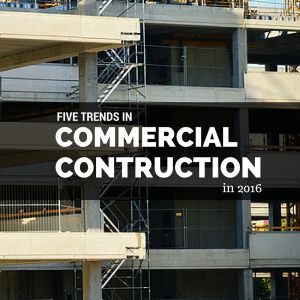 Last year’s predictions included everything from fabricating materials with 3-D technology to flying drones over the job site. Our industry is constantly evolving with innovations that move us forward while improving established practices. This year, commercial general contractors can expect to see these five trends in the construction industry.
Last year’s predictions included everything from fabricating materials with 3-D technology to flying drones over the job site. Our industry is constantly evolving with innovations that move us forward while improving established practices. This year, commercial general contractors can expect to see these five trends in the construction industry.
1. Increased Growth in Specific Markets
According to market analysts, national construction starts should rise 6 percent in 2016 to over $700 billion as the industry looks forward to a year of expansion. Reports also note that general construction activity is on track to advance by as much as 13 percent. The developing economic picture supports that outlook based on a slow uptick in long-term interest rates and moderate job growth. Commercial construction should enjoy an increased growth of 11 percent with an emphasis on markets in private development as well as finance and tech industries.
2. Higher Labor Cost Effects on Project Timelines
The increase in commercial construction growth is good news for the industry. However, subcontractors represent a substantial percentage of project costs, and most trades experienced layoffs during last year’s slowdown. Simple supply and demand principles still hold in place. Contractors take on more jobs while subs perform more work with less labor and charge higher costs accordingly. Contractors face tougher bidding decisions until available subcontracting labor returns to pre-recession numbers. As a result, many construction companies may advise clients to rethink their project timelines with an eye on controlling tight budgets.
3. Readily Available Building Information Modeling
Only a few years ago, this technology was applied to large-scale jobs by national firms. Today, BIM is accessible to any commercial construction company regardless of size. By applying digital capabilities that combine critical project data, this type of modeling produces easily shared formats. Along with traditional 3-D rendering, BMI coordinates information ranging from safety planning and budget figures to engineering management. The process ensures accurate, real-time data sharing and document generation.
4. Advanced Virtual Design and Construction Technology
While BIM functions as a digital hub for 3-D modeling and sharing data, its powers are rivaled by advances in VDC technology. This approach to project modeling adds 4-D capabilities to the process by introducing time elements into a job. This allows contractors and clients to coordinate factors that affect scheduling targets. VDC can also layer in 5-D concepts of cost that synchronize with a project’s 3- and 4-D models. The results facilitate collaboration between all parties while improving efficiency through all job phases.
5. Continued Emphasis on Green Construction
Every successful commercial construction company recognizes the significance of building green. This trend remains a strong industry force inspired by more than environmental responsibility. Clients understand the added value of energy-efficient construction. They also appreciate that life cycle cost reductions come at a higher price due to specialized materials. Today, they’re willing to make the investment. Projects that wouldn’t have generated an interest in LEED certification a few years ago are now candidates for green construction.
We make it our business to keep up with the latest technology, trends and economic forecasts. By always staying on top of change, we maintain our leadership position among commercial general contractors and deliver our best to clients across 15 states. Stovall Construction stands ready to take on any project today, and we’re always prepared to tackle future challenges with the very best design and construction talent in the industry. Contact us for more information.